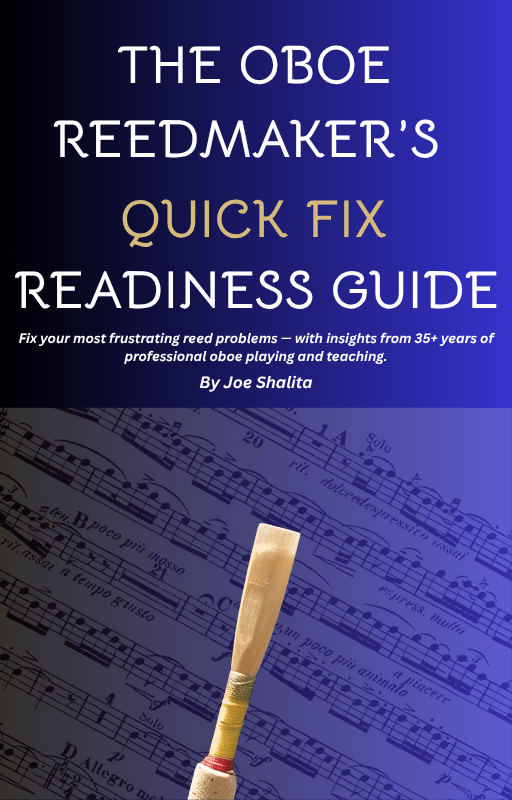The 5 Most Common Reedmaking Mistakes Beginners Make (And How to Fix Them)
There’s something humbling about learning to make your own reeds. One day it feels like you’re making progress. The next day, nothing works. The reed squeaks, chirps, or dies mid-note. Sound familiar?
After decades of teaching oboists at all levels, I can tell you that you're not alone. Most reedmakers, especially in the early stages, struggle with the same handful of problems. And while these mistakes are completely normal, they can hold you back from building confidence and consistency.
Here are the five most common ones I see, and how you can start moving past them.
1. It All Starts With the Cane
When a student brings me a reed that won’t vibrate or hold pitch, they often blame their scraping. But more often than not, the problem began long before the knife touched the cane.
Poor-quality cane, whether too soft, too hard, or inconsistent in density, will sabotage the entire reed. You can scrape with perfect technique, but if the material is fighting against you, the result will always fall short.
That’s why I always encourage reedmakers to start with cane from a trusted source. Learn to feel what good cane responds like. And when you find a batch that works, write it down and stick with it.
2. The Tip Trap
This one catches almost everyone at some point. The reed feels stiff when you crow it, so you remove a little cane from the tip. It still feels stiff. You try again. Suddenly, the reed is too thin, unstable, or starts chirping uncontrollably.
It’s a common instinct to go straight for the tip, but that’s rarely the right move. The real structure and flexibility of the reed lives in the back, in the heart, windows, and spine. If those areas are not balanced, the tip will never do what you want it to.
Think of the tip as the finishing detail, not the core of the reed. If the rest of the structure is right, the tip requires only minor adjustments.
3. Ignoring the Crow
The crow is your best friend, but many beginners don’t know how to use it. Some ignore it altogether. Others aren’t sure what they’re listening for.
A crow that is not clean an d 2 octaves usually means the reed isn’t balanced. A focused crow with no extra pitches tells you the reed has life and potential. It may not be perfect yet, but it’s on the right track.
Before you even think about putting the reed in your oboe, listen to the crow. It tells you more than the scrape or shape ever will. Learning how to interpret that sound is one of the most important skills you can develop.
4. The Balance Battle
I’ve seen reeds that look perfectly fine from the outside, but play completely unevenly. When we hold them up to the light, it becomes obvious. One window is too deep. The spine is off-center. The heart is lopsided.
Balance is everything. If one side is working harder than the other, the reed will fight you. It might feel heavy, unstable, or unpredictable.
Even if you don’t have fancy lighting tools, a basic lamp and a sharp eye will help you see what’s going on. Get used to backlighting your reeds. You’ll catch problems before they become real performance issues.
Try and scrape as even as possible. Each segment of the reed looks like its counterpart on the other blade as best as possible.
5. Copying Without Understanding
This last one is more mental than technical, but it’s just as important, plus it's one of my pet peeves.
Beginners often try to copy their teacher’s reeds exactly. Same dimensions, same shape, same numbers. But if you don’t understand why those choices work, or what to do when things don’t, you’ll get stuck the moment anything changes. Weather, cane, altitude, or even your oboe can throw everything off.
Reedmaking isn’t about producing clones. It’s about understanding relationships. How the heart affects response. How the windows influence pitch. How scraping changes the crow.
I always tell my students to take notes. Keep a journal. Try small experiments and see what happens. That curiosity is what turns you into a real reedmaker.
Final Thoughts
Reedmaking is a process. It’s part craft, part science, and part personal exploration. Mistakes are part of that process, but they don’t have to slow you down.
If you can avoid these five beginner mistakes, you’ll build confidence faster, spend less time frustrated, and get more joy out of your playing.
If this article helped you, I invite you to join my free weekly newsletter. I send tips, videos, photos, and reedmaking advice straight to your inbox — all based on what I’ve learned from 30 years of playing and teaching.
Copyright ©2025 Making Oboe Reeds




